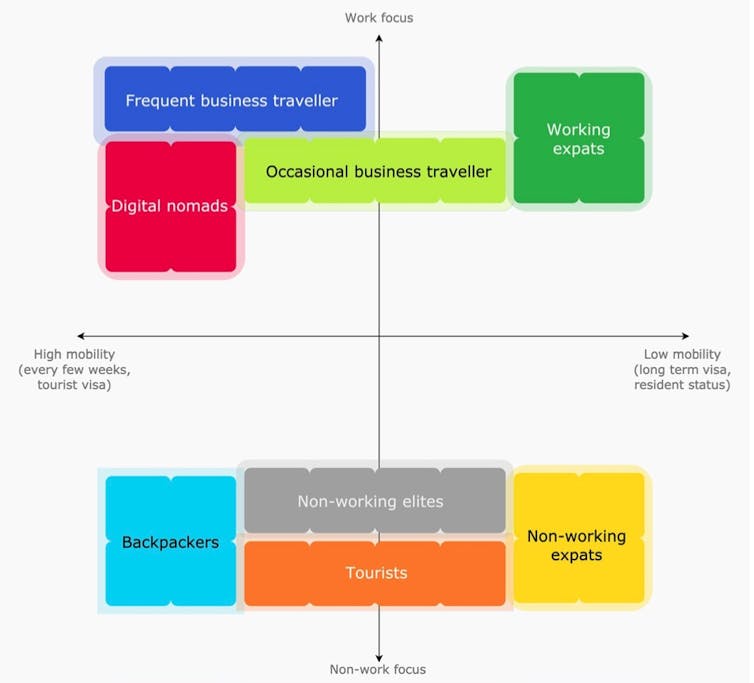Home » Posts tagged 'Remote work'
Tag Archives: Remote work
How did people respond to the disruption to work caused by the pandemic?
Our paper “The new normals of work: a framework for understanding responses to disruptions created by new futures of work” has just come out in Human-Computer Interaction Journal.
Open access to the paper is available here: https://www.tandfonline.com/doi/full/10.1080/07370024.2021.1982391
In the paper, we explore how people adapted to work during the pandemic and how we might understand people’s response to disruption in the new future of work. We highlight a number of issues, tools and strategies that people used in their work to support them while working remotely. For example, virtual commutes, having dedicated space, new scheduling techniques or staying connected with colleagues through virtual chats and async chats
Exploring these with the Genuis and Bronstein model of “new normal” we show 3 kinds of responses:
- waiting to return to old normal,
- finding a new normal and
- anticipating a new future of work.
These new normals of work help us to understand how we can help workers going forward.

We’d like to thank our reviewers for their feedback and our participants for helping develop our work within eworklife.co.uk and a special shoutout to @DilishaBP whose work with the new normal model inspired this work 😀 You can find their paper on Finding a “New Normal” for Men Experiencing Fertility Issues here: dl.acm.org/doi/abs/10.114…
If you find this interesting you might also like our other papers on work during the pandemic:
- Disengaged From Planning During the Lockdown? An Interview Study in an Academic Setting Yoana Ahmetoglu; Duncan P. Brumby; Anna L. Cox (2021) IEEE Pervasive Computing
- Staying Active While Staying Home: The Use of Physical Activity Technologies During Life Disruptions Joseph W. Newbold, Anna Rudnicka and Anna Cox (2021) Frontiers in Digital Health
- Eworklife: Developing effective strategies for remote working during the COVID-19 pandemic A Rudnicka, JW Newbold, D Cook, ME Cecchinato, S Gould, AL Cox (2020) The New Future of Work Online Symposium
The first draft of this blogpost was written as a twitter thread by Joe Newbold and unrolled using ThreadReader
The great remote work experiment – what happens next?

Sam Wordley via Shutterstock
Daniel Merino, The Conversation and Gemma Ware, The Conversation
In this episode of The Conversation Weekly, four experts dissect the impact a year of working from home has had on employees and the companies they work for – and what a more hybrid future might look like. And we talk to a researcher who asked people to sit in bathtubs full of ice-cold water to find out why some of us are able to stand the cold better than others.
For many people who can do their job from home, the pandemic meant a sudden shift from office-based to remote working. But after a year of working from home, some company bosses really don’t want it to become the new normal. The chief executive of Goldman Sachs, David Solomon, called it an “aberration”, and Barclays chief executive Jes Staley said it wasn’t sustainable, because of how hard it is to maintain culture and collaboration with teams working remotely.
Meanwhile, others are fully embracing a remote work future. Twitter said its employees could work from home forever, and Spotify announced a “work from anywhere” policy. Other firms are starting to announce more hybrid policies, where people are expected to split their week between the home and the office: in March, BP told employees they would be expected to work from home two days a week.
In this episode, we talk to researchers who have been studying the shift to remote working during the pandemic about their findings. In France, Marie-Colombe Afota, assistant professor in leadership, IÉSEG School of Management in France, talks us through the initial results of a new study she did in late 2020 of 4,000 employees at a large French multinational. “The more employees felt that the organisation generally values being visible in the office, the more they felt expected to be constantly available while in remote work,” says Afota. “And, in turn, two months later, the less they felt productive and happy in remote work.”
A year of working from home has left some people close to burnout, according to Dave Cook, a PhD researcher in anthropology at University College London who has been interviewing people about their experiences of shifting to remote work during the pandemic. “Burnout and work-life balance is the forgotten public health emergency that’s emerging through throughout this lockdown,” he tells us. And he says that companies should start communicating with their staff now about what the future has in store: “So their employees can get on with planning the rest of their lives.”
For others, the shift to remote work has been a surprisingly good experience. Jean-Nicolas Reyt, an assistant professor at McGill University in Montreal, has been tracking the language that chief executives in North America used to talk about remote working in 2020. “What you see is that actually that misconception, that telework is just not as efficient as co-located work, has vanished for a lot of CEOs,” he tells us. “A lot of CEOs and a lot of employees are saying it was forced, but it’s actually pretty good.”
Ruchi Sinha, a senior lecturer in organisational behaviour and management at the University of South Australia, gives the view from Australia, where hybrid working is already becoming a reality, and where most invitations to a face-to-face meeting now come with a video link too. But Sinha says that opportunities to shift to a fully flexible way of working may be being missed, with companies implementing new policies as rigid as the old ones. “I don’t think we are spending enough time thinking about are we giving people choice to shape their jobs, to shape what they do,” she tells us.
In our second story, we find out that your genes influence how resistant you are to cold temperatures. To test this, scientists asked a group of men to sit in bathtubs full of icy water to measure their reaction – and how much they shivered. Victoria Wyckelsma, a postdoctoral research fellow in muscle physiology at the Karolinska Institutet in Sweden, explains what they found and what it means.
And Sunanda Creagh from The Conversation in Australia gives us some recommended reading about the recent floods in Sydney.
Read more:
‘They lost our receipts three times’: how getting an insurance payout can be a full-time job
The Conversation Weekly is produced by Mend Mariwany and Gemma Ware, with sound design by Eloise Stevens. Our theme music is by Neeta Sarl. You can find us on Twitter @TC_Audio or on Instagram at theconversationdotcom. We’d love to hear what you think of the show too. You can email us on podcast@theconversation.com
A transcript of this episode is available here.
News clips in this episode are from CNN, CNBC News, CBC News, NBC News, Arirang News, World Economic Forum, Goldman Sachs, AlJazeera English, 7 News Australia, Sky News Australia,, Euronews, DW News and Jornal da Record.
You can listen to The Conversation Weekly via any of the apps listed above, our RSS feed, or find out how else to listen here.![]()
Daniel Merino, Assistant Editor: Science, Health, Environment; Co-Host: The Conversation Weekly Podcast, The Conversation and Gemma Ware, Editor and Co-Host, The Conversation Weekly Podcast, The Conversation
This article is republished from The Conversation under a Creative Commons license. Read the original article.
Media interview: ‘If you switch off, people think you’re lazy’: demands grow for a right to disconnect from work
Prof Anna L Cox is quoted in The Guardian’s article ‘If you switch off, people think you’re lazy’: demands grow for a right to disconnect from work
How the pandemic will shape the workplace trends of 2021

Elenabsl/Shutterstock
The economist John Maynard Keynes predicted in 1930 that the amount we work would gradually shrink to as little as 15 hours a week as technology made us more productive. Not only did this not happen, but we also began to spend extra time away from home due to commuting and suburban living patterns, which we often forget are recent historical inventions.
However, 2020 has changed all that. In my new history of remote work during COVID-19, I marvel at how much it has shaken up our lives and how much we took for granted. My research also points to a number of trends that will help shape working life in 2021.

Gene Daniels.
Over “in time for Christmas”
At the start of 2020 remote work was a gradually rising long-term trend. Only 12% of workers in the US worked remotely full time, 6% in the UK. Naturally the world was unprepared for mass remote work.
But COVID-19 instantly proved remote work was possible for many people. Workplace institutions and norms toppled like dominos. The office, in-person meetings and the daily commute fell first. Then the nine to five schedule, vacations and private home lives were threatened. Countries even started issuing remote work visas to encourage people to spend lockdown working in their territory.
As old norms vanished, a rapid procession of novel technologies marched uninvited into our homes. We had to master Zoom meeting etiquette, compassionate email practices, navigate surveillance, juggle caring responsibilities. The list goes on.
In the face of grim statistics – the UN predicted 195 million job losses – only the tone deaf complained about working from home. Nonetheless, COVID-19 created the biggest remote work experiment in human history.
In July, UK prime minister Boris Johnson – with Edwardian optimism – daydreamed a sense of normality would return “in time for Christmas”. Fast forward through summer to lockdown 2.0 and the fantasy of a 12-week experiment faded into sepia tinged memories. One interviewee joked: “I really thought we’d be back in the office by July, what fools we were!”
Are you disciplined?
Silicon Valley companies Google, Apple and Twitter were among the first to announce employees could work from home. Ahead of the curve, they were well practised. Predictably, they already had a fancy term for it: distributed working. In 2021 concepts such as distributed and hybrid working will proliferate.
Most were less prepared than Silicon Valley. In March, I published findings from a four-year research study tracking remote workers. I warned, to be a successful remote worker deep reserves of self-discipline were required, otherwise burnout followed.
We understand this now. But I spent the first lockdown patiently explaining to news outlets why working from home was so hard. When I suggested returning to the office might be considered a luxury – because it helped people structure their days – a news presenter laughed. For good or ill, conversations about disciplined routines will intensify in 2021.
Read more:
Remote working: the new normal for many, but it comes with hidden risks – new research
By May 2020 many reported experiencing Zoom fatigue. I naively predicted Zoom use would subside.
I’d have been right if we’d returned to the office. Instead necessity dictated we up our Zoom game – even if they were draining. Zoom simultaneously saved and ruined working from home, and it’s not going away anytime soon.

Michael D Edwards/Shutterstock
The commuting paradox
Remote workers, grateful to still have jobs, also reported a gnawing sense of survivors’ guilt. Overwork was one way of expressing this guilt. Many felt working extra hours might secure their job.
In April 2020, I joined other academics researching work-life balance on a project called eWorkLife. The research data revealed increases in working hours when it wasn’t obvious when the working day ended. Especially with no obvious signal to end the working day.
In my four-year remote study, I had noticed a strange pattern. Participants initially said “escaping the commute” was a key benefit of remote working. Yet months later these same workers started recreating mini commutes.
The eWorkLife project uncovered similar findings. People wanted to create “a clear division between work and home”. Study lead Prof Anna Cox urged people to do pretend commutes so they could maintain a work-life balance. In 2021 work-life balance must become recognised as a public health issue and the eWorkLife project is urging policymakers to act.

Khakimullin Aleksandr/Shutterstock
The right to disconnect
What’s happened to the time previously lost to commuting? Many are using it to catch up on admin and email. This taps into a worrying trend.
Pre-pandemic warnings about an encroaching 24/7 work culture were intensifying. Social scientists argued that contemporary workers were being turned into worker-smartphone hybrids. In 2016, French workers were even given the legal right to disconnect from work emails outside working hours.
A hopeful wish-list for 2021 includes continued increases in workplace activism and for companies and governments to reveal their remote working policies. Twitter and 17 other companies have already announced employees can work remotely indefinitely. At least 60% of US companies still haven’t shared their remote working policies with their employees. Remote workers tell me until bosses reveal their post-pandemic policies – planning for their future is impossible.
Read more:
Remote-work visas will shape the future of work, travel and citizenship
The late activist David Graeber described the failure to achieve Keynes’s 15-hour work week as a missed opportunity, “a scar across our collective soul”. COVID-19 may have started conversations about alternative futures where work and leisure are better balanced.
But it won’t come easily. And we will have to fight for it.![]()
Dave Cook, PhD Candidate in Anthropology, UCL
This article is republished from The Conversation under a Creative Commons license. Read the original article.
Talk: Games for Academic Life
Prof Anna L Cox gives keynote speech “Games for
Academic Life” at GALA 2020, Games and Learning Alliance conference.
A copy of the slides is available for download.
Media interview: Sandy Gould in The Loop
Dr Sandy Gould talks about the results of a study that we presented at the Microsoft Research New Future of Work Symposium “The New Remote Working Age” in Bridgehead Communication’s ‘The Loop’

The Global Remote Work Revolution and the Future of Work
Dave Cook, who has been collaborating with us on the eWorkLife Remote Work study has published a chapter in The Business of Pandemics book: The Global Remote Work Revolution and the Future of Work.
Remote-work visas will shape the future of work, travel and citizenship

During lockdown, travel was not only a distant dream, it was unlawful. Some even predicted that how we travel would change forever. Those in power that broke travel bans caused scandals. The empty skies and hopes that climate change could be tackled were a silver lining, of sorts. COVID-19 has certainly made travel morally divisive.
Amid these anxieties, many countries eased lockdown restrictions at the exact time the summer holiday season traditionally began. Many avoided flying, opting for staycations, and in mid-August 2020, global flights were down 47% on the previous year. Even so, hundreds of thousands still holidayed abroad, only then to be caught out by sudden quarantine measures.
In mid-August for example, 160,000 British holiday makers were still in France when quarantine measures were imposed. On August 22, Croatia, Austria, and Trinidad and Tobago were added to the UK’s quarantine list, then Switzerland, Jamaica and the Czech Republic the week after – causing continued confusion and panic.
This insistence on travelling abroad, with ensuing rushes to race home, has prompted much tut-tutting. Some have predicted travel and tourism may cause winter lockdowns. Flight shaming is already a cultural sport in Sweden, and vacation shaming has even become a thing in the US.
Amid these moral panics, Barbados has reframed the conversation about travel by launching a “Barbados Welcome Stamp” which allows visitors to stay and work remotely for up to 12 months.
Prime Minister Mia Mottley explained the new visa has been prompted by COVID-19 making short-term visits difficult due to time-consuming testing and the potential for quarantine. But this isn’t a problem if you can visit for a few months and work through quarantine with the beach on your doorstep. This trend is rapidly spreading to other countries. Bermuda, Estonia and Georgia have all launched remote work-friendly visas.
I think these moves by smaller nations may change how we work and holiday forever. It could also change how many think about citizenship.
Digital nomads
This new take on visas and border controls may seem novel, but the idea of working remotely in paradise is not new. Digital nomads – often millennials engaged in mobile-friendly jobs such as e-commerce, copywriting and design – have been working in exotic destinations for the last decade. The mainstream press started covering them in the mid-2010s.
Fascinated by this, I started researching the digital nomad lifestyle five years ago – and haven’t stopped. In 2015, digital nomads were seen as a niche but rising trend. Then COVID-19 paused the dream. Digital nomad Marcus Dace was working in Bali when COVID-19 struck. His travel insurance was invalidated, and he’s now in a flat near Bristol wondering when he can travel.
Dace’s story is common. He told me: “At least 50% of the nomads I knew returned to their home countries because of CDC and Foreign Office guidance.” Now this new burst of visa and border policy announcements has pulled digital nomads back into the headlines.
So, will the lines between digital nomads and remote workers blur? COVID-19 might still be making international travel difficult. But remote work – the other foundation of digital nomadism – is now firmly in the mainstream. So much so that remote work is considered by many to be here to stay.
Before COVID-19, office workers were geographically tethered to their offices, and it was mainly business travellers and the lucky few digital nomads who were able to take their work with them and travel while working. Since the start of the pandemic, many digital nomads had to work in a single location, and office workers have become remote workers – giving them a glimpse of the digital nomad lifestyle.

© Dave Cook and Tony Simonovsky, Author provided
COVID-19 has upended other old certainties. Before the pandemic, digital nomads would tell me that they despised being thought of as tourists. This is perhaps unsurprising: tourism was viewed as an escape from work. And other established norms have toppled: homes became offices, city centres emptied, and workers looked to escape to the country.
Given this rate of change, it’s not such a leap of faith to accept tourist locations as remote work destinations.
A Japanese businessman predicted this
The idea of tourist destinations touting themselves as workplaces is not new. Japanese technologist Tsugio Makimoto predicted the digital nomad phenomenon in 1997, decades before millennials Instagrammed themselves working remotely in Bali. He prophesied that the rise of remote working would force nation states “to compete for citizens”, and that digital nomadism would prompt “declines in materialism and nationalism”.
Before COVID-19 – with populism and nationalism on the rise – Makimoto’s prophecy seemed outlandish. Yet COVID-19 has turned over-tourism into under-tourism. And with a growing list of countries launching schemes, it seems nations are starting to “compete” for remote workers as well as tourists.
The latest development is the Croatian government discussing a digital-nomad visa – further upping the stakes. The effects of these changes are hard to predict. Will local businesses benefit more from long-term visitors than from hordes of cruise ship visitors swarming in for a day? Or will an influx of remote workers create Airbnb hotspots, pricing locals out of popular destinations?
It’s down to employers
The real question is whether employers allow workers to switch country. It sounds far-fetched, but Google staff can already work remote until summer 2021. Twitter and 17 other companies have announced employees can work remotely indefinitely.
I’ve interviewed European workers in the UK during COVID-19 and some have been allowed to work remotely from home countries to be near family. At Microsoft’s The New Future of Work conference, it was clear that most major companies were mobilising task forces and would launch new flexible working policies in autumn 2020.
Countries like Barbados will surely be watching closely to see which companies could be the first to launch employment contracts allowing workers to move countries. If this happens, the unspoken social contract between employers and employees – that workers must stay in the same country – will be broken. Instead of booking a vacation, you might be soon booking a workcation.![]()
Dave Cook, PhD Researcher, Anthropology, UCL
This article is republished from The Conversation under a Creative Commons license. Read the original article.
You are suddenly part of a virtual team.
Reblogged from an article by Evelyn Tan describing our work on using games to support the creation of digital teams
We were pushed into the age of fully remote work as abruptly as COVID-19 exploded across the globe. We are all suddenly part of a virtual team. We had no idea this was coming. And to be honest, it doesn’t seem like remote work is going to go away after things go back to “normal”.
Organisations are still scrambling to figure out how to deal with the ramifications of virtual work.
On the other hand, managers and team leaders are trying to figure out how to best keep their teams afloat.
But here’s some good news: Research on virtual teams — the challenges they face and how to make them effective — has been around since the Internet became a thing.
In this article, I highlight some of the most pressing challenges that you are going to face (or admittedly, have already faced) now that you are part of a virtual team. These challenges are primarily related to team processes — how do we get things done. I will also highlight some actionable solutions, based on scientific literature.
This article is meant for teams who are clear on their purpose, goals and roles but are struggling to set the right processes in place to achieve them. Without the former, the latter won’t get you anywhere.
Fun fact. Virtual work or remote work is also known as ‘telecommuting’, to refer to work where commuting time is reduced.
Problem 1: You can’t monitor your team. Trust is essential.
An effective virtual team requires a lot of trust because there is an increased sense of uncertainty. Since you cannot see people physically, you cannot monitor them like you previously could when co-located. If you micromanage, you will be exhausted, your colleague will be annoyed, and everyone becomes less productive. You need to trust that everyone has the team’s best interest in mind.
I like this definition of trust by Wilson, Straus and McEvily (2006, p.3)
Trust is the confident positive expectations about the conduct of another
The whole team becomes more productive when there is trust because less time will be spent checking up on each other and making contingency plans. We can have confidence that our team members will deliver on time.
Assuming that everyone is clear on their roles and their goals, how can we be confident that people are actively working towards them?
Solution: Encourage predictable communication through substaintial and timely responses.
In situations with high uncertainty, one way to build trust is to provide a lot of reasons to warrant trustworthiness. For virtual teams, this means exhibiting communication behaviours that give people a reason to trust you.
In an early study on the initial and final trust levels of global virtual teams, teams that were characterised as “high initial and high final trust” exhibited enthusiasm and excitement in the beginning and sustained frequent communication. Communication was not strictly task-focused but also included social content (i.e. things about their life outside of work).
This shows that teams with high levels of trust get there because they spend time developing all aspects of trust — trust based on rational reasons (e.g. Peter has always delivered his work on time) and trust based on emotional ties (e.g. Peter genuinely cares about my well-being).
Having substantial communication and timely responses helps to build up a history of reciprocal, positive interactions. The more actions someone has performed, the easier it is to predict or approximate their future behaviours. This feeds into our perception of their trustworthiness, which gives us confidence in our team members even if we do not see them. But this doesn’t mean we should be flooding the chat. Rather, our responsiveness should signal that we remain committed to achieving our goal.
The key point to remember is that trustworthiness is a function of prior successful ‘trust transactions’. Therefore, for new virtual teams, having substantial communication provides opportunities to validate trust, and timely responses strengthen perceptions of trustworthiness. As the team develops, less frequent communication is needed to maintain trustworthiness.
Problem 2: The way we interact with our team is going to change. Set guidelines for behaviour.
Spatial separation affects how team members interact with one another. Since the ability to walk up to a colleague and have a face-to-face conversation is suspended, interactions will become more effortful and less fluid. As shown in this study, this means that we can expect lags in information exchange, a higher chance of misunderstandings, and fewer attempts to seek information.
Since communication is asynchronous, it can also become overwhelming — if you’ve ever missed a text conversation that you are not an active participant of only to come back to 100 unread messages, you’ll know how this feels. A flurry of text chat, and endless back-scrolling could have been avoided through a simple phone call.
Solution: Use the right communication channel. Establish norms of functioning
Choose an appropriate communication channel. Effective virtual teams match the communication channel to the function of the interaction, or the task at hand. More complex tasks would require channels that allow higher synchronicity. For example, if the point of the interaction is to have a discussion that involves resolving previous ambiguities, brainstorming and problem solving, with a decision at the end, a video call is most appropriate as lags in information exchange are likely to be counterproductive. Having this interaction over text chat would be overwhelming. On the other hand, if the point of the interaction is to gather information, using email, text chat and phone calls will suffice.
Establish norms of functioning. Norms are particularly important in situations with high uncertainty (i.e. virtual teams) because it provides guidelines on how to behave. For virtual teams, establishing a guideline for how the team should function helps to regulate communication and work.
Day-to-day functions.
It is important to establish norms related to monitoring progress because there will be high ambiguity on what is appropriate behaviour. For example, everyone should be clear on how often to check and respond to messages. Everyone should also be clear on how often to provide status updates and check on other member’s status. By explicitly setting these norms, these behaviours are seen as necessary for team success, not because of paranoia or a lack of trust. On the plus side, research shows that trust is built when people adhere to norms.
Team meetings.
Ensure everyone has a chance to speak and contribute. High-performing teams are marked by equally distributed communication, virtual or not. When it is their turn, do not cut anyone off. Give people ample time to speak. As found in a study on predicting cohesion in virtual team meetings, the pause time between a person’s turn and the same person’s next turn was predictive of highly cohesive teams. This means that everyone should have a turn to speak and be given time to talk. If anyone is dominating the conversation, reel them back and encourage others to chip in.
It is also important to encourage people to be actively involved in the meeting, even if they are not speaking. The same study found that cohesion can be predicted most accurately by the amount of visual activity a person exhibits when they are not speaking. Gestures like nodding, for example, signal active listening. In video calls, where virtual team meetings likely take place, everyone can be seen head-on. This means that it is easy to tell who is listening and who isn’t. Norms should be established around engagement and participation in virtual team meetings.
Problem 3: Everybody is going to feel more distant. Invest time in team bonding.
When we are co-located, interpersonal relationships develop through spontaneous interactions with our colleagues. There are intentional interactions as well, but the ‘random chats’ and ‘coffee breaks’ are actually crucial to developing bonds. It has been found to increase cohesion and productivity.
When teams become virtual, there is no more water cooler to congregate around. Since communication is more effortful, it can be heavily task-focused and less about the social lives of others. If your team members do not already have strong interpersonal relationships, virtual work can make them feel more distant from their colleagues.
Solution: Make time for social chat and play video games together.
In the current climate, it can be easy to just make virtual everything that we used to do in a co-located space. Virtual Friday night drinks and virtual pub quizzes are the go-to post-work activities. These activities usually take place over a video call, but as the world has come to realise, conducting typically co-located experiences through a screen is exhausting. Using the same virtual space for work and fun doesn’t provide enough separation. If people are on the same platform that they use to do work (e.g. Zoom, Teams, Skype), with work-related people (i.e. colleagues) but doing an activity that is not work-related, it might not create enough mental distance for recuperation — social activities will still feel like work.
So, consider playing a video game instead.
By this, I mean games where everyone is represented as an avatar in a virtual world, and video call is not required. ‘Zoom Fatigue’ has become a thing and is so taxing on our brain because video calls require greater attentional effort and make us feel more self-conscious. Playing video games together, on the other hand, is a shared activity that lets people truly wind down. And there are several reasons why.
Video games are unique because they are immersive experiences — they draw people into the game and make them momentarily forget what’s happening in the real world. So it’s no surprise that digital games have been found to aid post-work recovery. And one of the reasons is because it helps people to detach both physically and mentally from work.
Video games are also completely different virtual environments. Everyone is likely represented as an avatar that does not resemble their ‘real world’ selves. People can embark on activities that they do not usually do in their day-to-day.
Video calls are also not required — using ‘voice chat’ over Discord is the preferred method for gamers. This means that nobody will feel conscious about how they look, or about people looking at them.
Finally, you will be engaging in an activity that is inherently built for fun and enjoyment. The whole interaction has nothing to do with work and everything to do with the social experience.
So it’s no surprise that video games have been found to support deep social relationships. The game provides opportunities for shared experiences which becomes a catalyst for conversation. Bonds are formed over the experience and we learn more about the people we work with, beyond the work that they do.
Don’t know what to play? Here are a couple of 4-player team-based games that I’ve really enjoyed playing with my friends. They are easy to learn, easy to set up and don’t have high system requirements.
- Lovers in a Dangerous Spacetime (local co-op only)
- Unrailed! (online co-op)
Tying it all together.
To develop an effective virtual team, conscious and intentional effort is required. The three main challenges that virtual teams face are:
- difficulty in monitoring performance
- learning how to interact through computer-mediated mediums
- overcoming feelings of distance
In this article, I’ve highlighted how these challenges can be addressed. By focusing on developing trust, developing norms of functioning and developing social bonds, the foundation for virtual team effectiveness can be built.
Digital work-life Boundaries for when you’re working from home
Prof Anna L Cox talks to Andrew Kun and Orit Shaer about Digital work-life Boundaries for when you’re working from home on their Future of Work Conversations webinar

